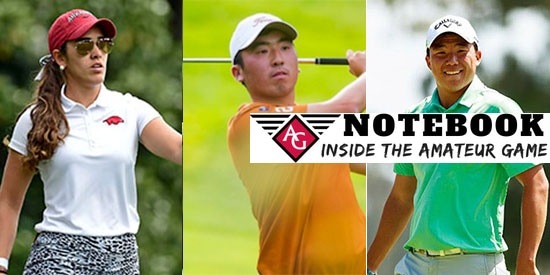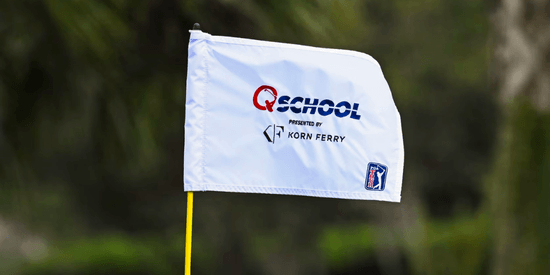Notebook: Defining postseason awards; Pasatiempo post-script
4/23/2019 | by Julie Williams of AmateurGolf.com
see also: Western Intercollegiate Men's College Golf Tournament, Pasatiempo Golf Club

College golf's postseason awards bear some very recognizable names, but do you know what each represents?
Sorenstam and Fassi will now share a bond, as Sorenstam does with many up-and-comers in women’s golf. Her name draws people in to this sector of the game, where up until 2014, there was no such award for female collegians. But there's more to it than that.
“It’s more than just sharing a golf tip, a lot of it is personal,” Sorenstam said after hitting a ceremonial tee shot at the Augusta National Women’s Amateur. Later that afternoon, Fassi engaged in a memorable back nine duel before ultimately coming up short.
When the Haskins Commission recognized that it needed a female equivalent to its Haskins Award, Sorenstam’s name stood out. Like the Haskins Award, the Annika Award is voted on by players, coaches, SIDs and media members. Both awards are presented by Stifel.
“We knew that partnering with Annika would be great. She moves the needle maybe unlike any other female player,” said Brian Stubbs, Executive Director of the Fred Haskins Commission.
In addition to the Haskins Award, there are a handful of coveted, named and merit-based awards on the table for male collegians. Here’s a look at what they represent, and what makes them different:
HASKINS AWARD: As mentioned, the Haskins Award is unique in its selection process. The winner is voted on by players, coaches, SIDs and select golf-focused media members. The theory is that people within the golf community – particularly the players who are competing alongside each other all season long – have the best feel for which player should rise to the top.
The Haskins Award has been given since 1971, and dates to a conversation at the Dixie Intercollegiate, a college tournament that was annually played at Callaway Gardens in Pine Mountain, Ga. Lanny Wadkins was then a member of the Wake Forest men's team and was having an outstanding year. In search of a way to honor him, a group present at the Dixie started brainstorming.
“They got a group of gentlemen together who knew college golf and formed the Fred Haskins commission with the mission of recognizing the most outstanding collegiate golfer,” Stubbs said. “It was put in place in 1970 and the first award was given in 1971.”
As a perk, the Haskins Award winner annually receives an exemption to play the Greenbrier Classic on the PGA Tour.
The Haskins name stands as a way to honor the individuals who often have the most impact on college golfers: club professionals. Fred Haskins was the longtime pro at the Country Club of Columbus (Ga.), who mentored dozens of men on their way to successful amateur and college careers.
“He was an interesting guy, unassuming to a large extent, loved for others to have the fanfare and have the success,” Stubbs said of Haskins, who passed away in 1981. “(The award is) a tribute to him but also sends a clear message that it’s a village that gets you here.”
HOGAN AWARD: The Ben Hogan Award takes into account a player’s entire body of work over a year-long period, and in all facets of the game. That means any college event, amateur event or professional event in which an amateur competes goes into consideration. The selection committee includes voices from across the golf landscape, from the PGA of America to the R&A to the USGA to members of the media.Stifel congratulates Norman Xiong of the University of Oregon – winner of this year’s Fred Haskins Award! pic.twitter.com/mX1H9LYVOP
— Stifel (@Stifel) June 7, 2018
“As much as amateur golf is aligned with college golf, it’s really different from any other sport,” notes Dustin Roberts, Deputy Director of the GCAA, which gives the award in partnership with Friends of Golf and Colonial Country Club.
The award was co-founded by Hogan and Tom Harmon, who won the 1940 Heisman Trophy while at the University of Michigan, with the goal of creating the college golf version of the Heisman. The award was first given in 1990, and includes an exemption into the annual PGA Tour event played at Colonial Country Club. The Hogan Award has only been based on the current criteria, however, since 2002. Before that, it looked much like the current Byron Nelson Award (see below), meaning that academics and community service also figured in heavily.
The winner also needs to know his way around a banquet hall. The list of candidates is slowly whittled to three men throughout the course of the season, and all three attend a black-tie banquet at Colonial Country club the week of the Charles Schwab Challenge. The winner is revealed that evening.
NELSON AWARD: The Byron Nelson Award is given to a college golfer not only for golf merit, but for strength of character. The recipient must be a graduating senior, and consideration is given for his entire career on the basis of golf, academics and community service. Five candidates are chosen mid-season, with only one winning the award.As the 2018-19 college golf season gets underway, let's take a look back at former @TexasMGolf great @DougGhim's experience at the @BenHoganAward ceremony in May. Whose name will be added to the trophy in 2019?
— The Ben Hogan Award (@BenHoganAward) September 11, 2018
Full 📹: https://t.co/lJjE7wkygb pic.twitter.com/XGZonpKSRF
NICKLAUS AWARD: The Jack Nicklaus Award is essentially the GCAA’s player of the year award, and it is awarded across all levels of the game: NCAA Divisions I, II and III, plus NAIA and NJCAA. All winners receive their trophies from Jack Nicklaus himself during the week of the Memorial, but the Division I player also receives an exemption into the tournament.
MICKELSON AWARD: Up until 2004, this award was simply named “Freshman of the Year.” It feels a little more prestigious now that it carries Phil Mickelson’s name, who as an Arizona State freshman in 1989 famously won the first of his three NCAA titles.
The Mickelson Award is also given across all levels of college golf.
• • •
WESTERN INTERCOLLEGIATE POST-SCRIPT: John Kennaday has had TV on the brain for years – at least as it relates to the Western Intercollegiate presented by Topgolf. The San Jose State coach committed to getting the long-running event back on TV (it was last broadcast nationally in 1996, when San Jose State’s Arron Oberholser outplayed Stanford’s Joel Kribel and Tiger Woods over the final nine holes), and in partnership with Golf Channel, he made it happen. It wasn’t a weeks- or months-long labor of love. It truly took years.
“We worked as a partnership from Day 1 and explored all of our resources,” Kennaday said. “We both knew that it was a big deal and that it would be a huge hit, we just had to find a way to cover the costs, which are extensive.”
In retrospect, a number of things made last week's Western Intercollegiate work in a unique way: a Monday-to-Wednesday time slot, a spot in the week after the Masters (when golf hype is big) and a venue, Pasatiempo Golf Club, also designed by Alister MacKenzie (he of Augusta National fame).
Kennaday has poured energy into advancing the game in this way, but it’s a concept with which he is familiar, having been on the NCAA Golf Committee when Golf Channel began broadcasting the NCAA finals. Still, there was something heartening about watching San Jose State, which entered the week ranked No. 61 in the Golfweek/Sagarin College Rankings, perform so well when the stakes were so high. After leading through Rounds 1 and 2, the Spartans finished third.
The home-course advantage plays a role, of course, but for the record, San Jose State players rarely see Pasatiempo in tournament condition. It becomes a different beast, and it’s a totally different experience for San Jose State rookies, which is why Kennaday is careful about putting them in the Western lineup.
Kennaday calls this year’s San Jose State squad one of tremendous character, and its Western performance will serve as a major confidence boost. Belief is powerful.
“We’ve seen flashes of brilliance for about a year and a half and the flashes are starting to come a little closer together,” Kennaday said. “It’s going to start to glow here pretty soon and at some point we’ll be able to shine.”
San Jose State next tees it up April 26-28 at the Mountain West Conference Championship.
• • •The #WesternIntercollegiate is under way! @SJSUAthletics @SJSU @PasatiempoGolf pic.twitter.com/Y6Oy8iRRML
— Jeff Sanchez (@JeffSanchezPGA) April 15, 2019
THE PEOPLE WANT MATCH PLAY: The players asked for it, so the American Junior Golf Association is delivering. This summer’s Polo Golf Junior Classic at Liberty National will be played as a round-robin style match-play event. It’s a unique format (the first of its kind since 1978) that was borne of feedback shared from player representatives Rachel Kuehn and William Mouw.
“A lot of players voiced to me they wanted an opportunity to play in a match play tournament,” Kuehn said in an AJGA press release. “It is fun, exciting and allows a player to express more emotion than he or she normally would. This different style of play also provides an opportunity for players to be more aggressive in their style of play and gain experience that will serve them in future USGA and NCAA tournaments.”
An initial field of 64 players (based on the Rolex AJGA Rankings) will begin the event and will consist of 32 boys (Polo Division) and 32 girls (Liberty Division). They will be further divided into eight groupings of four players each to compete in three guaranteed singles matches, to be played June 25-26. The top eight Polo Division boys and Liberty Division girls from each group after pool play will advance to single-elimination matches, to be played June 27-28. Match play champions for the Polo Golf Junior Classic at Liberty National will be crowned on Friday, June 28.
This marks the second recent change to the Polo event, which used to be played in late November. The event had traditionally been a match-play event but changed to stroke play in 2017.
• • •
STAT OF THE WEEK: CHASING LUCKY (AND HISTORIC) NO. 7
When first-year USC women's head coach Justin Silverstein guided the Trojans to the Pac-12 title on April 17, USC’s sixth this season, he left open the possibility of achieving a rare feat. Only one NCAA women's coach has won more tournaments in their debut season than Silverstein. According to research from USC Athletics, that was current Vanderbilt head coach Greg Allen, who began his head coaching career at Arizona (Silverstein’s alma mater) with six wins in the 2000-01 season. In addition to Silverstein, Colette Murray, as a first-year head coach at Tennessee-Chattanooga, won five tournaments in 2007-08, the same year the program debuted.
• • •
TOURNAMENTS TO WATCH:
Junior Invitational at Sage Valley, Sage Valley Golf Club, Graniteville, S.C., April 25-27
The skinny: The premier event in junior golf, where teenagers are treated like PGA Tour players. The event is played just down the road from Augusta National, and will be heavily attended by top college coaches. Expect Sage Valley to also be one of defending champion Akshay Bhatia’s final junior-golf starts as he moves on to amateur golf and, in the near future, professional golf.
Asia-Pacific Women’s Amateur, The Royal Golf Club, Hokota, Japan, April 25-28
The skinny: Last year’s inaugural event produced a very worth champion in Atthaya Thitikul, as well as some excitement courtesy of a four-woman playoff for the title. Highlights in this year’s field include local favorite Yuka Yasuda, fresh off a top-3 finish at the Augusta National Women’s Amateur, and don’t forget there’s an exemption to the 2020 ANWA on the line. College players you may recognize include Rollins’ Seher Atwal from India and Stanford commit Lei Ye from China.
U.S. Women’s Amateur Four-Ball, Timuquana Country Club, Jacksonville, Fla., April 27-May 1
The skinny: It’s the first real tournament of the USGA championship season, and with Colorado State players Katrina Prendergast and Ellen Secor back to defend.
• • •
TWEET OF THE WEEK: SO MUCH MORE AT STAKE
Random thought after playing a round at the site of this year’s U.S. Amateur:
— Sean Martin (@PGATOURSMartin) April 16, 2019
The stakes will be even higher in the final match. They’ll be playing for a pairing with Tiger at Augusta National.
• • •
SHOT(S) OF THE WEEK: The first made Sports Center’s Top 10, but the second was SEC tournament-defining
ICYMI: Emily Price was featured on today's @SportsCenter Top 10! We still can't get over this chip! #SECWGolf #SCTop10 pic.twitter.com/hQsZd2NnV8
— Gamecock W. Golf (@GamecockWGolf) April 22, 2019
ARE YOU SERIOUS⁉️
— Ole Miss Women’s Golf (@OleMissWGolf) April 21, 2019
Macy Somoskey extends her match with a HUGE putt on 18 👀
🖥️ https://t.co/egpqlsCLOp
📊 https://t.co/qaOaRskiZN pic.twitter.com/DAEFIO34Tz
Most Popular Articles

2025 PGA TOUR Q-School Guide: Sites, Scores, and Who Advanced
Dec 5, 2025Second Stage is complete and Final Stage awaits at Sawgrass — follow every Q-School leaderboard and the players still chasing
2025 LPGA TOUR Q-Series: Final Qualifying Stage FINAL SCORING
Dec 8, 2025Helen Briem earns medalist honors, 31 players headed to the LPGA next year
Australian Open at Royal Melbourne: Preview, amateur bios, and how to watch
Nov 30, 2025Rory McIlroy headlines one of the championship's top fields in years - at least four amateurs will have their chance at glory
Luke Ringkamp Cruises to Rolex Tournament of Champions Title at TPC San Antonio
Nov 26, 2025One week after committing to Pepperdine, Luke Ringkamp won the Rolex Tournament of Champions by nine shots.Inside Gil Hanse’s Restoration of Baltusrol’s Upper Course: A Return to Tillinghast’s
Dec 11, 2025Renowned architect Gil Hanse reveals how he brought Baltusrol’s Upper Course back to life by honoring A.W. Tillinghast’s originalLoading latest news...
